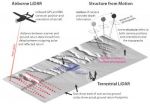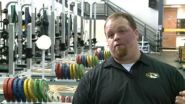(Press-News.org) Scientists discovered two new species of sea-dwelling, mushroom-shaped organisms, according to a study published September 3, 2014 in the open-access journal PLOS ONE by Jean Just from University of Copenhagen, Denmark, and colleagues.
Scientists classify organisms based on shared characteristics using a taxonomic rank, including kingdom, phylum, and species. In 1986, the authors of this study collected organisms at 400 and 1000 meters deep on the south-east Australian continental slope and only just recently isolated two types of mushroom-shaped organisms that they couldn't classify into an existing phylum.
The new organisms are multicellular and mostly non-symmetrical, with a dense layer of gelatinous material between the outer skin cell and inner stomach cell layers. The organisms were classified as two new species in a new genus, Dendrogramma enigmatica and Dendrogramma discoides, in the new family, Dendrogrammatidae. Scientists found similarities between the organisms and members of Ctenophora and Cnidaria and suggest that they may be related to one of these phyla. Scientists also found similarities to 600 million year-old Pre-Cambrian extinct life forms, suggested by some to be early but failed attempts at multi-cellular life.
The authors originally preserved the specimens in neutral formaldehyde and stored them in 80% ethanol, which makes them unsuitable for molecular analysis. However, they suggest attempting to secure new samples for further study, which may provide further insight into their relationship to other organisms.
Jørgen Olesen added: "New mushroom-shaped animals from the deep sea discovered which could not be placed in any recognized group of animals. Two species are recognized and current evidence suggest that they represent an early branch on the tree of life, with similarities to the 600 mill old extinct Ediacara fauna."
INFORMATION:
In your coverage please use this URL to provide access to the freely available paper: http://dx.plos.org/10.1371/journal.pone.0102976
Citation: Just J, Kristensen RM, Olesen J (2014) Dendrogramma, New Genus, with Two New Non-Bilaterian Species from the Marine Bathyal of Southeastern Australia (Animalia, Metazoa incertae sedis) – with Similarities to Some Medusoids from the Precambrian Ediacara. PLoS ONE 9(9): e102976. doi:10.1371/journal.pone.0102976
Funding: This work was supported by an Australian Marine Science and Technology/Australian Research Council grant. The funder had no role in study design,
data collection and analysis, decision to publish, or preparation of the manuscript.
Competing Interests: The authors have declared that no competing interests exist.
New deep sea mushroom-shaped organisms discovered
Organisms' discovery spurs identification of 2 new species
2014-09-03
ELSE PRESS RELEASES FROM THIS DATE:
IU researchers isolate process that damages lungs of donors with traumatic brain injury
2014-09-03
INDIANAPOLIS -- Few people would guess that some of the most detrimental damage from a traumatic brain injury is to the lungs, but transplant specialists are keenly aware of this phenomenon. Indiana University research published Sept. 3 in Science Translational Medicine sheds light on the potentially lethal process.
Research conducted by an interdisciplinary team co-led by Fletcher A. White, Ph.D., the Vergil K. Stoelting Professor of Anesthesia, and David S. Wilkes, M.D., executive associate dean for research affairs and director of the Center for Immunobiology at the ...
Is type 2 diabetes 'diabetes' as currently understood?
2014-09-03
The current way of diagnosing type-2 diabetes using blood glucose levels needs to be revised, research by scientists from The University of Manchester and King's College London suggests.
The findings, published in the journal PLOS ONE today (3 September), show the current method of diagnosis - using blood glucose levels - means patients are diagnosed too late so that their blood vessels may already be damaged.
Type 2 diabetes, which affects over 90% of all adults with diabetes, often leads to heart damage and blood vessel problems in the brain, eyes and kidneys. It ...
Biodiversity in the balance
2014-09-03
A new study calls into question the evolutionary stability of an ecological explanation of biodiversity.
The study, published in the journal PLOS ONE, brings together evolutionary theory and ecology to explore one of the big questions in ecology: How is biodiversity developed and maintained?
"This is a fundamental question if we want to protect biodiversity—what exactly do we need to protect?" says IIASA Evolution and Ecology Program Director Ulf Dieckmann, who led the study together with Florian Hartig from the University of Freiburg, collaborating with colleagues from ...
Penn study demonstrates wearable sensors to detect firearm use
2014-09-03
A new study from the University of Pennsylvania demonstrates that wearable sensors could one day transform the correctional system by tracking gun use by community-based offenders, who account for a disproportionate share of fatal and non-fatal shootings.
Currently, detecting and deterring this type of crime can be challenging in the absence of reliable evidence that a particular community-supervised offender illegally used a firearm.
In the study, published this week in the journal PLOS ONE, Charles Loeffler, an assistant professor of criminology at Penn, demonstrates ...
Widely used depression drug associated with dental implant failure
2014-09-03
Alexandria, Va., USA – The International and American Associations for Dental Research (IADR/AADR) have published a paper titled "SSRIs and the Risk of Osseointegrated Implant Failure – A Cohort Study." Selective Serotonin Reuptake Inhibitors (SSRIs), the most widely used drugs for the treatment of depression, have been reported to reduce bone formation and increase the risk of bone fracture. Since osseointegration is influenced by bone metabolism, this study investigates the association between SSRIs and the risk of failures in osseointegrated implants. The manuscript, ...
Story from the Department of Energy's Oak Ridge National Laboratory, Sept. 2014
2014-09-03
To arrange for an interview with a researcher, please contact the Communications staff member identified at the end of each tip. For more information on ORNL and its research and development activities, please refer to one of our media contacts. If you have a general media-related question or comment, you can send it to news@ornl.gov.
OPTICS – Precision projectile tracker …
Rifle optical sighting systems with a 19th century heritage could blast into modern times with a laser-based bullet tracking system being developed by a team led by Slobodan Rajic of Oak Ridge National ...
Trouble starting a task? Perception of time may be the problem, study finds
2014-09-03
Completing tasks and crossing them off the ubiquitous "to-do" list is a great feeling. But what about those nagging tasks we keep putting off? What's the difference between those jobs that get completed and those that do not?
The answer may be our perception of time, according to new research by Yanping Tu, a doctoral candidate at the University of Chicago's Booth School of Business.
The study, "The Categorization of Time and Its Impact on Task Initiation," recently published in the Journal of Consumer Research, finds that people are more likely to begin a job when, ...
How much gravity is enough?
2014-09-03
TORONTO, September 3, 2014 – Keeping upright in a low-gravity environment is not easy, and NASA documents abound with examples of astronauts falling on the lunar surface. Now, a new study by an international team of researchers led by York University professors Laurence Harris and Michael Jenkin, published today in PLOS ONE, suggests that the reason for all these moon mishaps might be because its gravity isn't sufficient to provide astronauts with unambiguous information on which way is "up".
"The perception of the relative orientation of oneself and the world is important ...
Team develops new, inexpensive method for understanding earthquake topography
2014-09-03
Boulder, Colo., USA – Using high-resolution topography models not available in the past, geologists can greatly enrich their research. However, current methods of acquisition are costly and require trained personnel with high-tech, cumbersome equipment. In light of this, Kendra Johnson and colleagues have developed a new system that takes advantage of affordable, user-friendly equipment and software to produce topography data over small, sparsely vegetated sites at comparable (or better) resolution and accuracy to standard methods.
Their workflow is based on structure ...
Study sets guideline for determining effectiveness of college football training methods
2014-09-03
VIDEO:
Athletic performance varies from day to day, which can make it difficult for strength and conditioning professionals to judge whether athletes' improvements are due to effective training. Now, University of...
Click here for more information.
COLUMBIA, Mo. –Athletic performance varies from day to day, which can make it difficult for strength and conditioning professionals to judge whether athletes' improvements are due to effective training. Now, University of Missouri ...
LAST 30 PRESS RELEASES:
Danforth Plant Science Center to lead multi-disciplinary research to enhance stress resilience in bioenergy sorghum
Home-delivered groceries improve blood sugar control for people with diabetes facing food insecurity
MIT researchers identified three cognitive skills we use to infer what someone really means
The Iberian Peninsula is rotating clockwise according to new geodynamic data
SwRI, Trinity University to study stable bacterial proteins in search of medical advances
NIH-led study reveals role of mobile DNA elements in lung cancer progression
Stanford Medicine-led study identifies immune switch critical to autoimmunity, cancer
Research Alert: How the Immune System Stalls Weight Loss
Glucagon-like peptide 1 receptor agonist use and vertebral fracture risk in type 2 diabetes
Nonadherence to cervical cancer screening guidelines in commercially insured US adults
Contraception and castration linked to longer lifespan
An old jeweler’s trick could unlock next-generation nuclear clocks
Older age, chronic kidney disease and cerebrovascular disease linked with increased risk for paralysis and death after West Nile virus infection
New immune role discovered for specialized gut cells linked to celiac disease
A new ‘hypertropical’ climate is emerging in the Amazon
Integrated piezoelectric vibration and in situ force sensing for low-trauma tissue penetration
Three-hit model describes the causes of autism
Beech trees use seasonal soil moisture to optimize water uptake
How thinning benefits growth for all trees
Researchers upgrades 3-PG forest model for improved accuracy
Achieving anti-thermal-quenching in Tb3+-doped glass scintillators via dual-channel thermally enhanced energy transfer
Liquid metal modified hexagonal boron nitride flakes for efficient electromagnetic wave absorption and thermal management
Failure mechanisms in PEM water electrolyzers
Study captures how cancer cells hide from brain immune cells, shows that removing their “don’t eat me” signals stops their escape
New breakthrough in detecting ‘ghost particles’ from the Sun
Half of people arrested in London may have undiagnosed ADHD, study finds
From dots to lines: new database catalogs human gene types using ’ACTG’ rules
Persistent antibiotic resistance of cholera-causing bacteria in Africa revealed from a multinational workshop for strengthening disease surveillance
SwRI, Trinity University to synthesize novel compound to mitigate effects of stroke, heart attack
Novel endocrine therapy giredestrant improves disease-free survival over standard of care for patients with early-stage breast cancer in phase III lidERA trial
[Press-News.org] New deep sea mushroom-shaped organisms discoveredOrganisms' discovery spurs identification of 2 new species


